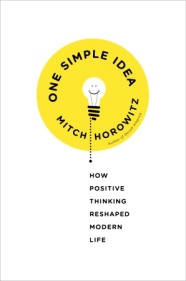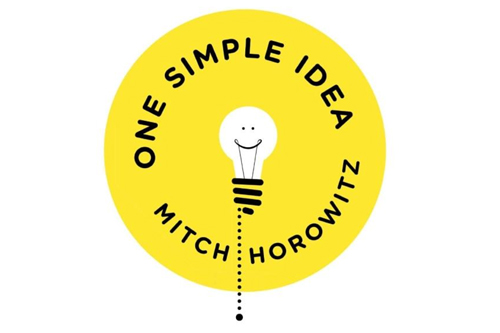 In his new book One Simple Idea: How Positive Thinking Reshaped Modern Life (Crown Publishing Group), Mitch Horowitz tells the fascinating story of the “loosely knit band of psychical researchers and religious philosophers, mental-healers and hypnotists, Mesmerists and Spiritualists, Unitarians and Transcendentalists, suffragists and free-love advocates, black liberationists and Christian socialists, animal-rights activists and Biblical communists, occultists and Freemasons, artists and freethinkers” who came together in the nineteenth century to create New Thought and Christian Science, two closely related movements that turned on the power of what William James would later term the “mind cure” or what we commonly refer to today as the power of positive thinking.
In his new book One Simple Idea: How Positive Thinking Reshaped Modern Life (Crown Publishing Group), Mitch Horowitz tells the fascinating story of the “loosely knit band of psychical researchers and religious philosophers, mental-healers and hypnotists, Mesmerists and Spiritualists, Unitarians and Transcendentalists, suffragists and free-love advocates, black liberationists and Christian socialists, animal-rights activists and Biblical communists, occultists and Freemasons, artists and freethinkers” who came together in the nineteenth century to create New Thought and Christian Science, two closely related movements that turned on the power of what William James would later term the “mind cure” or what we commonly refer to today as the power of positive thinking.
For thousands of years, mystics had proposed that what we perceive as reality is in fact a projection of our own minds and ego desires—that true reality abides beyond time, space, and the flesh. But if those mystics sought to transcend the world, this new breed of modern thinkers offered a kind of applied idealism that promised to transform the world instead. If “thoughts are things,” as Prentice Mulford wrote in the 1890s, a “substance as much as the acids, oxides, and all other chemicals,” then they can be used to turn disease into health, poverty into wealth, and addiction into mastery. Just as industrialism had harnessed the powers of electricity and magnetism, the invisible powers of mind were a new kind of technology that was just waiting to be tapped.
But in 1948 any number of thinkers, preachers, counselors, and authors were telling real people that they too could think their lives wonderful. Norman Vincent Peale’s first bestseller, A Guide to Confident Living, came out that same year, paving the way for his mega-selling The Power of Positive Thinking in 1952.
Heckle and Jeckle’s uncanny powers were specific to cartoons, a universe where the laws of physics don’t apply. But in 1948 any number of thinkers, preachers, counselors, and authors were telling real people that they too could think their lives wonderful. Norman Vincent Peale’s first bestseller, A Guide to Confident Living, came out that same year, paving the way for his mega-selling The Power of Positive Thinking in 1952.
The idea has even more currency today, as can be seen in the phenomenal success of Rhonda Byrne’s The Secret, the Chicken Soup for the Soul series, prosperity preachers like Joel Osteen and Creflo Dollar, and motivational gurus like Anthony Robbins.
Think positive is practically the American creed, Horowitz writes. “It forms the foundation of business motivation, self-help, and therapeutic spirituality,” and it is arguably the philosophy that had the deepest influence on Ronald Reagan, who imbibed it first from his mother, then from the chiropractor and spiritualist B.J. Palmer, who owned the first radio station where he worked, and later from some of Hollywood’s most influential astrologers and occultists.
Recent developments in quantum physics, neuroscience, and the systematic study of placebo effects in medicine provide objective reasons to believe that thoughts can and do exert concrete influences on the physical world.
Where positive thinking falls short, he recognizes, is in its ethical shallowness and its narcissism. Everything doesn’t happen for a recognizable purpose: Even the righteous suffer, and for reasons that remain unfathomable. “New Thought’s pioneers,” Horowitz writes, “never pondered the potential limitation, or disadvantages, of man’s place in creation.” Like the false comforters in the Book of Job, too many of its apostles were too quick to blame victims for their own suffering, either because they failed to think rightly or because they were paying a karmic price for bad acts they committed in previous lives. Such arguments, he writes, are not just presumptuous; they deny the mystery that is at the heart of religion. “Man is neither all-seeing nor all-knowing; and his creative faculties, whatever their nature, cannot surpass his point of perspective.” On the other hand, recent developments in quantum physics, neuroscience, and the systematic study of placebo effects in medicine provide objective reasons to believe that thoughts can and do exert concrete influences on the physical world.
Horowitz’s verdict? New Thought may only be “a little bit true”—but it is true enough to potentially change everything. “Acting with deep practical intent,” he concludes, the pioneers of positive thinking “probed the possibilities and capacities of our psyches earlier than any scientists, theologians, or psychologists of the modern industrialized age. The founders of New Thought and affirmative thinking created a fresh means of viewing life, one that was rough and incomplete, rough with mistakes and dead ends, but also filled with possibility and practical application.”
“Mind power” is too influential an idea to simply dismiss it out of hand, as so many otherwise open-minded people do. One Simple Idea fills a need for a serious-minded history of this neglected aspect of the American ethos, while casting an intriguing look forward at its yet unrealized potential.
Related Articles




2 Comments